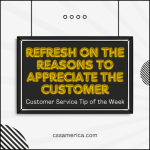
Confidence in your ability to deliver customer service is exceptionally important. I often quote Vince Lombardi who said “Confidence is contagious, and so is lack of confidence. And the customer can recognize both.”
Confidence is important to you and to the customer. It lets the customer know whether they can trust and believe you, or not. Should they follow what you say, or should they “answer shop?” Should they accept your explanation, or should they ask you 15 follow-up questions? Much of their response (and whether they end up wasting your time or the time of your co-workers) is based on your confidence.
So, what creates confidence?
Judith Bardwick (management consultant, psychiatrist, author) once said: Real confidence comes from knowing and accepting yourself – your strengths and your limitations – in contrast to depending on affirmation from others.
Starting with the last point first, don’t seek affirmation from others in order to drive your confidence. If you receive the compliments, then great! That’s a bonus. But don’t rely on someone else to do something for you in order for you to create a positive self-image.
Bardwick believes that being confident outwardly is based on your inward knowledge. Do you know your own strengths and weaknesses (or “limitations”)? Do you accept those? When I say “accept,” I’m not saying that you should refuse to improve, but at least be honest that that’s who you are at that specific moment.
Do this exercise to build your confidence in front of customers. Simply take out a sheet of paper, and write down 5-10 of your strengths that relate to customer service such communications, relationship-building, organizational skills, and other characteristics of people great at customer service. Then, write down 5-10 areas that are shortcomings or at least not your core strengths.
Then review the list. Tell yourself “yes, this is me at this moment. I am REALLY good at these 5-10. These other points are areas where I’m not great and may need to improve in the future.”
That knowledge and acceptance will help you to be more conscious of what to leverage when serving others (your strengths), and what situations to avoid or seek support in (your limitations).
Get to know yourself better to serve your customer more confidently.
Signup for FREE Tips! Contact Us More Resources for You Visit Our Home Page























